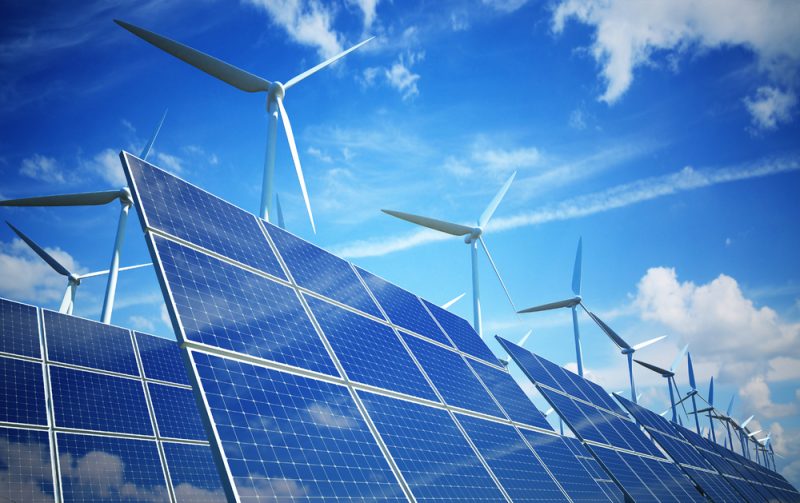Midterm elections boost odds for renewables expansion

A newly elected team of state legislators and governors around the country who are considered friendly to renewable energy takes the field this winter and could clear the way for a new growth spurt in wind and solar generation.
The midterm elections in various key states resulted in leadership at the respective state capitals that have indicated they would at least be receptive to expanding the renewable energy portfolios or had, in fact, made renewables part of their campaign platforms, a new post-election analysis from the research and consulting firm Wood Mackenzie concluded.
“This has created a new political landscape where the probability of additional renewables is greatly increased,” said the report, titled “U.S. State-Level Renewable Policy Implications of Midterm Elections.”
Wood Mackenzie said it remained to be seen what specific changes the individual states might make to their policies and to the mandates of their renewable portfolio standards (RPS). But, the report said, “In each of these states, RPS increases are likely to be a major driver of renewable capacity additions.”
Fourteen states elected Democratic governors in November, including seven states that had Republican administrations in office. Six of the new governors had campaigned on pledges to increase their RPS mandates.
“We definitely saw more Democrats campaigning on promises of expanding renewables, especially in the gubernatorial races,” Colin Smith, a senior utility analyst at Wood Mackenzie Power & Renewables and a co-author of the report, told Daily Energy Insider. “Solar and wind are cost-effective in most markets, and we have seen both sides campaign on promoting renewables to bring in jobs and lower energy costs for consumers.”
Wood Mackenzie estimated that if all 14 incoming Democrats achieved 50 percent compliance on their proposed RPS increases by 2030, it would create additional solar generation of up to 28.5 gigawatts of AC electricity (GWac) along with 20.9 GWac of wind power.
“While actual policy changes and incremental capacity addition remain subject to significant uncertainty, it is clear the outcome of the midterm elections has improved the state-level policy environment and added tremendous upside potential to the U.S. renewables market,” the report said.
The 10 individual states that transitioned from Republican red to Democrat blue included:
- Nevada: Steve Sisolak campaigned on the idea of someday powering Nevada with 100 percent renewable power. The voters approved a ballot measure that calls for a more modest target: 50 percent renewables by 2030. And even that goal faces another public vote in 2020.
- Colorado: Jared Polis also went big during the campaign, calling for an ambitious 100 percent renewables target by 2040. Colorado and neighboring Wyoming have ample wind resources. Colorado, however, is also a mining state, giving coal a voice in the state legislature.
- Illinois: The state is wrestling with budget issues and is considered unlikely to make any major moves on energy until the situation becomes more stable. The southern end of the state is home to several coal-fired power plants, but the Midcontinent Independent System Operator (MISO) has plenty of new renewable capacity coming online should the state decide to head in that direction.
- Michigan: The state’s two largest utilities committed in 2016 to boost their fuel mix to 50 percent renewables by 2030. That made RPS a moot point in the campaign. Wood Mackenzie also noted that the state’s natural-gas pipeline network is expanding, meaning gas power plants will continue to play a major role in Michigan’s fuel mix.
- New Mexico: The state has ample wind and solar resources, which enabled Michelle Lujan Grisham to make some bullish calls for 50 percent RPS by 2030 and 80 percent by 2040. But those goals would require some major increases in capacity, and New Mexico is already eager to become a supplier of green electricity for California.
- Minnesota: Another state that has some top-tier winds to exploit, Minnesota will have a Democratic governor and Republican-led state legislature in 2019. What might help is the large renewables portfolio held by NRG Energy, the state’s largest utility.
- Wisconsin/Kansas: Two states with Republican legislatures, a fact that Wood Mackenzie says will likely keep RPS expansion on the back burner. Wisconsin’s wind resources are considered modest and the state’s wind-power prices are already among the lowest in the nation.
- Connecticut/Maine: Ned Lamont proposed building Connecticut’s RPS to 100 percent by 2040. The question remains whether hydroelectric imports from Canada and the output of the state’s Millstone nuclear power plant would be part of an expanded mix. Maine will likely undo legislative barriers to renewables put in place by the outgoing GOP administration, but transmission constraints in the state will also have to be addressed.
Moreover, Wood Mackenzie’s report did not address questions surrounding the structure of multi-state power markets, which are on the plate of the Federal Energy Regulatory Commission. The issues in general revolve around giving renewables access to the grid and keeping them competitive with gas-generated power.
“There are plenty of regulatory and market issues that could hinder RPS expansion,” Smith said. “The impacts of RPS increases can be far reaching and even potentially prevent RPS increases in several states; however, the political pressure alone could drive additional renewables.”
